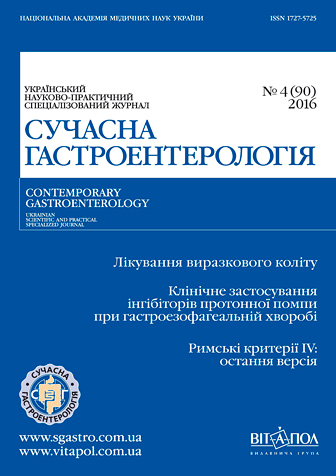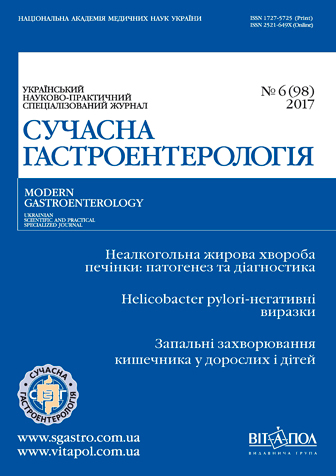- Issues
- About the Journal
- News
- Cooperation
- Contact Info
Issue. Articles
¹4(90) // 2016

1. Original researches
|
Notice: Undefined index: pict in /home/vitapol/sgastro.vitapol.com.ua/en/svizhij_nomer.php on line 74 The effects of body weight and concomitant pathology of the biliary tract on the onset and progression of lipid abnormalities in patients with nonalcoholic fatty liver disease in combination with obesityYu. M. Stepanov1, A. Yu. Filippova21 SI «Institute of Gastroenterology of NAMS of Ukraine», Dnipro |
|---|
Materials and methods. The study involved 100 patients (19 men and 81 women) with NASH in combination with obesity and BT pathology, who at the time of sonographic and morphological study of liver biopsy revealed signs of hepatic steatosis. Themean age of patients was 53.82 ± 1.12 years. The control group consisted of 20 healthy persons. Depending on the degree of increase in body mass index (BMI), all patients with NASH were divided into three groups: group 1 included subjects with BMI of 25 — 29.9 kg/m2 (overweight); group 2 consisted of patients with a BMI 30 — 34.9 kg/m2 (obesity I degree); group 3 with a BMI 35- 39.9 kg/m2 (obesity II degree). Depending on the BT pathology, the patients were divided into 3 groups: NASH with chronic non-calculous cholecystitis; NASH with chronic calculous cholecystitis; NASH in patients after laparoscopic cholecystectomy (LCE) with concomitant post-cholecystectomic syndrome (PHES). The determine the lipid exchange characteristics, total cholesterol (TCHOL), total lipids (TL), triglycerides (TG), low density lipoproteins (LDL-CHOL), high density lipoproteins (HDL-CHOL) were measured. The DL phenotype was determined by the classification D. S. Fredrickson with recent addenda.
Results. For all NASH patients, the lipid exchange disorder were typical in comparison with the healthy controls: as regards the levels TCHOL, TG, TL, LDL-CHOL) (p < 0.05; p < 0.001). The highest indices of TCHOL, TG, TL, LDL-CHOL were revealed in NASH patients combined with obesity I degree (p < 0.001) and obesity II degree (p < 0.001), and the lowest indices of lipid profile were revealed at th overweight (p < 0.05; p < 0.001). The BT comorbidities partially affected the lipid profile indicators. Thus, with NASH HDL-CHOL in patients with concomitant PHES was at normal values, as compared with a low level of HDL-CHOL in patients with chronic non-calculous and calculous cholecystitis, which may indicate a lesser severity of inflammation in the BT after LCE and further can reduce atherogenic LDL-CHOL fractions.
Conclusions. The progression of intensity of the lipid imbalance in NASH patients in combination with obesity and biliary tract pathology significantly depends on the BMI parameters and partially (as relates to some lipid spectrum indices) depends on the presence of concomitant biliary tract pathology. Two main phenotypes DL IIa and IIb have been determined, and their comparison with the nosology and disease stage made it possible to consider them as the main phenotypes, specific for the investigated comorbidity.
Keywords: non-alcoholic steatohepatitis, obesity, biliary tract, lipid metabolism, body mass index.
![]() To download
To download
full version need login
Original language: Ukrainian
2. Original researches
|
Notice: Undefined index: pict in /home/vitapol/sgastro.vitapol.com.ua/en/svizhij_nomer.php on line 74 Pathomorphological changes of esophageal mucosa in patients with combination of gastroesophageal reflux disease and arterial hypertensionO. Ye. GridnyevSI «L. T. Mala National Therapy Institute of NAMS of Ukraine», Kharkiv |
|---|
Materials and methods. The study included 89 patients with gastroesophageal reflux disease and 126 patients with GERD in combination with arterial hypertension, mean age was (41.99 ± 1.57) and (55.92 ± 0.91) years, respectively. The histological investigations were performed on the biopsies, obtained at the video-endoscopy of the distal esophageal mucosa. The specimens were stained with hematoxylin and eosin. The investigations were performed on the mucosa specimens from the esophagus with esophagitis signs and compared them with the intact esophageal mucosa. The normal esophageal epithelium (control group) was defined as the absence of visible erosions at endoscopy and no basal cell hyperplasia, elongated papillae or cellular infiltrates on histological examination.
Results. The frequency of erosive reflux esophagitis in patients with comorbidity is higher than in patients with isolated gastroesophageal reflux disease (p < 0.05). Both groups were characterized by basal cell hyperplasia, elongation of the lamina propria papillae with vascular congestion, dilated intercellular spaces, focal or diffuse infiltration of the epithelium by polymorphonuclear leucocytes, and manifested hyperkeratosis, proliferation of basal cells and acanthosis. This change could represent a mucosal reaction towards recovery of the epithelial barrier. Morphometric study revealed a significant increase in the thickness of the basal layer of the epithelium and the papillae height both at isolated GERD, and at comorbidity compared to control (p < 0.05). Increasing in the basal layer of the esophageal mucosa epithelium thickness is less pronounced in comorbid patients compared with isolated pathology. Hyperplasia of the basal layer of the epithelium, the elongation of papillae, parakeratosis, acanthosis and neutrophilic infiltration found in both groups, with almost the same frequency. Vascular lesions (irregular hypertrophy of the muscular layer, focal sclerosis, hyalinosis and narrowing of the arteries), ectasia of venules, formation of perivascular hemorrhage; swelling and degeneration of the epithelium are more prevalent in the mucosa of comorbid patients compared to isolated gastroesophageal reflux disease (p < 0.05).
Conclusions. Combination of GERD and arterial hypertension resulted in the morphological and histological disorders in the esophageal mucosa, that may be associated with the pathogenetical causes of arterial hypertension, hypoxia and endothelial dysfunction.
Keywords: gastroesophageal reflux disease, arterial hypertension, esophageal mucosa, histological and morphometric analysis.
![]() To download
To download
full version need login
Original language: Russian
3. Original researches
|
Notice: Undefined index: pict in /home/vitapol/sgastro.vitapol.com.ua/en/svizhij_nomer.php on line 74 Indexes of lipid metabolism in patients with acute edematous pancreatitis depending on the genes IL-4 (C-590T), TNF-α (G-308A), PRSS1 (R122H), SPINK1 (N34S) and CFTR (delF508C) polymorphismS. I. Ivashchuk, L. P. SydorchukBukovinian State Medical University, Chernivtsi |
|---|
Materials and methods. Genetic studies have been performed for 123 patients with edematous pancreatitis, among whom were 23 (18.7 %) women and 100 (81.3 %) men. The control group consisted of 40 healthy age- and gender-matched subjects. Gene PRSS1 (R122H) was investigated in 123 patients, CFTR (delF508) and IL-4 (C-590T) — in 101, SPINK1 (N34S) — in 63, TNF-α (G-308A) — in 11. Genes polymorphism was studied with the method of PCR using oligonucleotide primers company Metabion (Germany). The research of the lipids included the determination of the levels of total cholesterol (TC), triglycerides (TG), high-density lipoprotein cholesterol (HDL-C) and low-density lipoprotein cholesterol (LDL-C) and Apolipoprotein (Apo) B using the reagents of the firm «Thermo Fisher Scientific» (Finland), and calculation atherogenic index (AI).
Results. À pronounced dyslipidemia was revealed in the most part of patients. In NN genotype carriers of the gene CFTR (delF508) higher levels of TC, HDL-C and LDL-C were determined, while NM genotype carriers had the highest levels of TG, Apo B and AI. In the GG genotype carriers of the gene PRSS1 (R122H) significantly increased indexes of the TC, HDL-C, LDL-C and uncertain — TG, Apo B and AI. In the TT-genotype carriers of the gene IL-4 (C-590T) were observed higher levels of TC, HDL-C and LDL-C, while in the owners of the C-allele — higher content of TG, Apo B and AI. By GG genotype of the gene TNF-α (G-308A) were higher levels of TC, HDL-C and LDL-C compared with GA-genotype carriers in which have been higher TG, Apo B and AI.
Conclusions. The course of edematous pancreatitis was accompanied by significant dyslipidemic changes that had no clear correlation with the polymorphic variants of the gene CFTR (delF508) (hypercholesterolemia in the NN-genotype owners, hypertriglyceridemia — in NM carriers) gene PRSS1 (R122H) (more significant hypercholesterolemia in patients with GG-genotype, p < 0.01), IL-4 gene (C-590T) (increase of the TC by LDL-C in the TT-genotype owners) and TNF-α (G-308A) (hypercholesterolemia in GG- carriers hypertriglyceridemia — in persons with GA-variant).
Keywords: pancreatitis, polymorphism, lipids, gene, CFTR (delF508), PRSS1 (R122H), IL-4 (C-590T), TNF-α (G-308A).
![]() To download
To download
full version need login
Original language: Ukrainian
4. MEDICINES
|
Notice: Undefined index: pict in /home/vitapol/sgastro.vitapol.com.ua/en/svizhij_nomer.php on line 74 Dysbiosis and bacterial overgrowth syndrome at the irritable bowel syndrome: correction with the use of Saccharomyces boulardii CNCM I -745S. M. Tkach1, À. Å. Dorofeev2, Ì. Ì. Rudenko21 Ukrainian Research and Practical Centre of Endocrine Surgery, Transplantation of Endocrine Organs and Tissues of the Ministry of Health of Ukrainå, Kyiv |
|---|
Keywords: irritable bowel syndrome, intestinal dysbiosis, bacterial overgrowth syndrome, probiotics, Saccharomyces boulardii CNCM I-745.
![]() To download
To download
full version need login
Original language: Russian
5. MEDICINES
|
Notice: Undefined index: pict in /home/vitapol/sgastro.vitapol.com.ua/en/svizhij_nomer.php on line 74 The choice of the treatment strategy of patients risk of the upper gastrointestinal bleedingsG. D. Fadieienko, T. A. SolomentsevaSI «L. T. Mala National Therapy Institute of NAMS of Ukraine», Kharkiv |
|---|
Keywords: ulcers, gastrointestinal bleeding, Helicobacter pylori, NSAID-associated gastropathy, proton pump inhibitors, omeprazole, Îmez.
![]() To download
To download
full version need login
Original language: Russian
6. MEDICINES
|
Notice: Undefined index: pict in /home/vitapol/sgastro.vitapol.com.ua/en/svizhij_nomer.php on line 74 Rabeprazole: the news about the famousN. V. Bezd³tkoNational University of Pharmacy, Kharkiv |
|---|
Keywords: acid-dependent diseases, treatment, proton pump inhibitor, rabeprazole.
![]() To download
To download
full version need login
Original language: Russian
7. MEDICINES
|
Notice: Undefined index: pict in /home/vitapol/sgastro.vitapol.com.ua/en/svizhij_nomer.php on line 74 Pantoprazole: peculiarities of pharmacokinetics, acid-inhibiting actions, clinical efficacy and safetyV. Ì. Chernobrovyy, O. Î. KsenchónNational Pirogov Memorial Medical University, Vinnytsya |
|---|
Keywords: pantoprazole, pharmacokinetics, acid-inhibiting action, êëèíè÷åñêàÿ clinical efficacy, safety profile.
![]() To download
To download
full version need login
Original language: Ukrainian
8. MEDICINES
|
Notice: Undefined index: pict in /home/vitapol/sgastro.vitapol.com.ua/en/svizhij_nomer.php on line 74 Influence of L-arginine and betaine on structural and functional state of erythrocytes, lipids and homocysteine blood levels in patients with nonalcoholic steatohepatitisV. V. KharchenkoP. L. Shupyk National Medical Academy îf Postgraduate Education, Kyiv |
|---|
Materials and methods. Investigation involved 50 patients with NASH against the background of abdominal syndrome, from them 29 (58 %) women, and 21 (42 %) men with the mean age 38 to 60 years. Anthropometric, clinical laboratory, biochemical studies, ultrasound of the abdominal cavity have been conducted.
Results. The following changes of structural and functional state of erythrocytes were revealed before the treatment in patients with NASH: reduction of the deformation index, aggregation index, relative contact hemolysis, intensity of red blood cells and glucose utilization, the decrease of the in erythrocyte ATP levels and erythrocytes resistance to the peroxidation, and increase of the relative viscosity of erythrocyte suspension (p < 0.001), indicating the microcirculatory disorders. After the treatment, patients of the main group demonstrated considerable improvement of the structural and functional erythrocytes’ status. Thus, one of the most important indicators deformation index, characterizing the ability of erythrocytes to change their form with the purpose of oxygen transport to the terminal parts of the microvasculature, increased in 1.7 times in patients of the main group after 4 months of treatment (p < 0.001). Treatment with the Betargin contributed to the improvement of structural and functional indicators of erythrocytes. The relative viscosity of erythrocyte suspension reduced in 2.1 times, aggregation index increased in 1.9 times, the relative contact hemolysis increased in 1.6 times, ATP in 1.9 times. Moreover, the intensity of glucose metabolism in erythrocytes and resistance to the peroxidation increased (ð < 0.001), and positive dynamics of the blood lipid spectrum enhanced (ð < 0.001).
Conclusions. The study revealed positive effects of Betargin on the lipid metabolism, homocysteine blood levels, as well as on the structural-functional state of erythrocytes.
Keywords: Betargin, L-arginine, betaine, nonalcoholic steatohepatitis, erythrocyte, lipids, homocysteine.
![]() To download
To download
full version need login
Original language: Ukrainian
9. MEDICINES
|
Notice: Undefined index: pict in /home/vitapol/sgastro.vitapol.com.ua/en/svizhij_nomer.php on line 74 The use of L-glutathione for the pathogenetic protection of stomach and liver in patients with type 2 diabetes mellitusM. B. Shcherbinina1, N. M. Palibroda2, M. V. Patratii2, |
|---|
Materials and methods. This open comparative study included 84 patients with DM 2 (39 men and 45 women) with a mean age of 53.8 ± 7.6 years. Rapid urease test and a stool antigen test were used to determine H. pylori infection in each patient. Quadruple therapy was administered for 14 days. After eradication therapy, patients were randomized into two groups, each of42 patients: subjects from the main group received Hepaval 2 caps. twice a day in addition to basic therapy (basic group 1) for six weeks, while 42 patients received only basic therapy (comparative group 2).
The upper endoscopy, morphological study of gastric biopsy specimens (semiquantitative evaluation of composition and degree of infiltration of gastric mucosa, the total volume density of the microvasculature); liver sonographic parameters (size, degree of steatosis) and the degree of liver fibrosis, according to RTE-elastography; liver enzymes were evaluated before and after the treatment period.
Results. In both groups, the successful eradication of H. pylori resulted in the reduction of inflammation endoscopic signs, the healing stomach and duodenal ulcers, the epithelialization of gastroduodenal erosions, accompanied with improved histology of gastric mucosa, reduction of gastritis activity degree. With this, patients of the maingroup 1, administered Hepaval, demonstratedmore significant improvement, while dysmotility of upper gastrointestinal tract and gastroduodenal mucosal defects were revealed in patients from comparison group. In both groups, significant (p < 0.001) reduction in inflammatory cell infiltration was found. However, these indices were significantly better (p < 0.05) in the main group, while in comparison group 2 more significant inflammatory infiltration of gastric mucosa, degenerative and necrotic changes in epithelial cells with the presence of multiple cases of gastroduodenal erosions were still present after the bacteria elimination. The manifestations of atrophic changes of the stomach mucosa, intestinal metaplasia, microvasculature condition, hepatomegaly, steatosis (1 — 2 degree), fibrosis (F0-F2) were not statistically different before and after treatment. At the same time, the normalization of transaminases was indicated in the main group 1 after 6 week treatment with Hepaval. In the comparison group 2, serum aminotransferase levels were not statistically different at the end of treatment period and significantly (p < 0.05) differed from group 1 patients.
Conclusions. Based on the data of endoscopy and morphological studies, Hepaval (L-glutathione) contributed to more rapid recovery of the natural state of gastroduodenal mucosa during regression of Helicobacter pylori-induced gastritis. The inclusion of Hepaval in the basic therapy resulted in the fast normalization of liver enzymes at NASH. Hepaval did not cause seriousside effects, requiring drug discontinuation, and was well tolerated. The additional Hepaval (L-glutathione) inclusionin the complex therapy of patients with type 2 DM is pathogeneticallyjustifiedby its effects in eliminating metabolic disorders in gastroduodenal mucosa and liver.
Keywords: diabetes mellitus type 2, non-alcoholic fatty liver disease, steatohepatitis, Hepaval, L-glutathione, gastroduodenal mucosa.
![]() To download
To download
full version need login
Original language: Ukrainian
10. MEDICINES
|
Notice: Undefined index: pict in /home/vitapol/sgastro.vitapol.com.ua/en/svizhij_nomer.php on line 74 Sofosbuvir in the treatment of chronic viral hepatitis C: facts and expectationsO. V. KolesnikovaSI «L.T. Mala National Therapy Institute of NAMS of Ukraine», Kharkiv |
|---|
Keywords: chronic viral hepatitis C, sustained virological response, sofosbuvir, efficiency, safety.
![]() To download
To download
full version need login
Original language: Russian
11. Reviews
|
Notice: Undefined index: pict in /home/vitapol/sgastro.vitapol.com.ua/en/svizhij_nomer.php on line 74 Therapeutic treatment strategies of ulcerative colitis: realities and futureI. E. KushnirSI «L.T. Mala National Therapy Institute of NAMS of Ukraine», Kharkiv |
|---|
Keywords: ulcerative colitis, treatment, aminosalicylates, corticosteroids, immunosuppressive, tumour necrosis factor alpha monoclonal antibody, adhesion molecules inhibitors.
![]() To download
To download
full version need login
Original language: Russian
12. CLINICAL CASE
|
Notice: Undefined index: pict in /home/vitapol/sgastro.vitapol.com.ua/en/svizhij_nomer.php on line 74 Clinical application of the proton pump inhibitors in the treatment of gastroesophageal reflux disease (cases from clinical practice)O. O. Bondarenko1, Î. Ì. Agibalov21 Danylo Halytskiy Lviv National Medical University |
|---|
Keywords: atypical and refractory forms of the gastroesophageal reflux disease, clinics, diagnosis, treatment, proton pump inhibitors.
![]() To download
To download
full version need login
Original language: Russian
Current Issue Highlights
¹6(98) // 2017

Chronic inflammatory bowel disease and viral infections
E. I. Sergienko
The phenomenon of Helicobacter pylori-negative ulcer and its place in clinical practice
V. ². Vdovychenko 1, Ya. B. Shvydkyi 1, A. V. Ostroglyad 2
Log In
Notice: Undefined variable: err in /home/vitapol/sgastro.vitapol.com.ua/blocks/news.php on line 51

